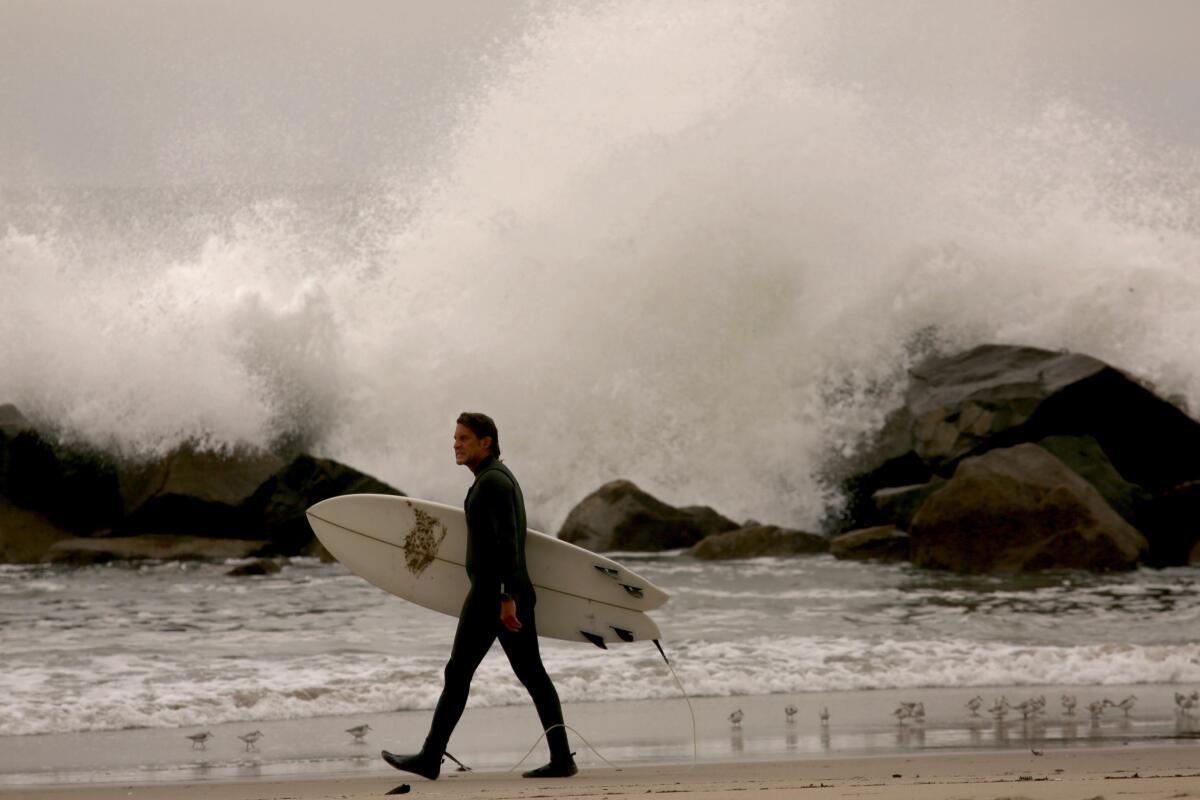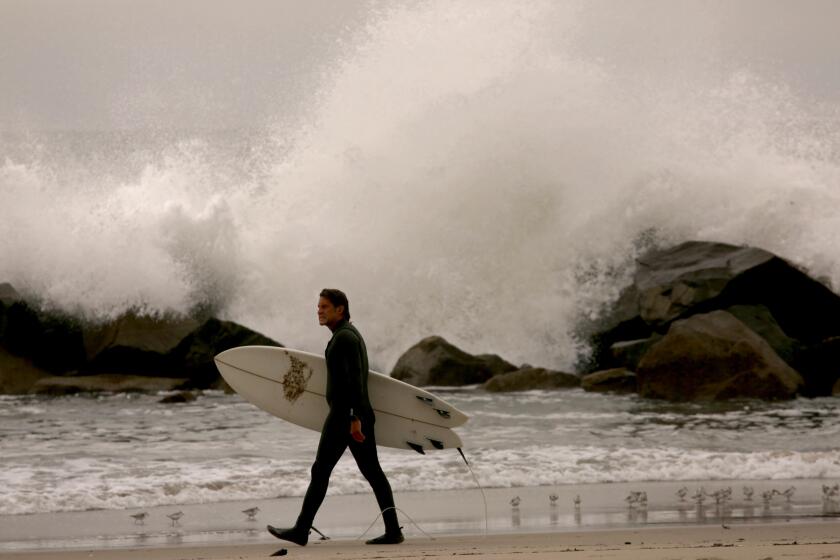On California beaches, tsunami brings choppy waves, isolated flooding and much curiosity

- Share via
The tsunami activity that hit the California coast on Saturday brought modest waves, flooding in some locations and much curiosity.
There were no reports of major damage or injuries, with most areas seeing 1- to 2-foot waves. Officials did not expect major flooding but warned that the situation — caused by a volcano erupting near the South Pacific nation of Tonga — posed dangers to swimmers, surfers and boats. Beaches and harbors up and down the coast were closed.
The surge swept into Santa Cruz Harbor, causing flooding and jostling boats, said Ashley Keehn, public information officer for the Santa Cruz County Sheriff’s Office. Deputies and the Harbor Patrol evacuated people from the harbor early Saturday, including some people who live aboard boats.
“We went boat to boat evacuating the docks and making sure there wasn’t anyone inside that could potentially be in danger,” Keehn said.
The water level rose several feet in the harbor, she added.
“There have been some minor waves rolling in,” Keehn said. “We have seen some boats getting knocked around a little bit.”
One car was submerged in seawater up to the tops of the tires, she said. No injuries were reported.
Authorities planned to assess any damage once the water receded, Keehn said. “With the water still being a pretty high level, it’s hard to assess the damage right now.”
A tsunami advisory was issued for the California coast Saturday morning. Here is what we know:
Initial reports from Santa Cruz Harbor indicated little damage to vessels moored there.
Gordon Rudy, a Realtor who keeps a 28-foot cabin cruiser on U-Dock, watched the surge from the harbor parking lot after being evacuated and said, “There are no boats being damaged at this point.”A decade ago, a tsunami caused by a Japanese earthquake left the harbor with damage estimated at more than $20 million.
People present for both events said Saturday’s surge was relatively mild.
“We saw very little debris floating in the channel. Nothing compared to 2011,” said contractor Scott Sommers, who spent the night on his 32-foot power boat in preparation for early morning crabbing. When the tsunami advisory was issued before dawn, boat owners roused sleeping neighbors.
Some opted to take their boats out to the open sea for safety, while others decided to leave their vessels in place and watch from land or a railroad bridge overlooking the harbor. The surge arrived shortly after 8 a.m., they said, and was markedly different from the violent waves of the 2011 tsunami.
“There were no big waves. It would just surge in and surge back out,” Sommers said. He and Rudy estimated the water quickly rose as much as 8 feet and then flowed out just as rapidly.
“Like high tide and low tide happened in two or three minutes,” Sommers said. While the boats seemed to survive the surge, water breached the embankment, flooding parking lots and streets.
As of 11 a.m., the harbor remained closed and inaccessible to owners to inspect boats. Rudy, whose boat suffered nearly $30,000 damage in the 2011 tsunami, said he purchased a new boat in October and was relieved that it appeared to have escaped harm. “You have an absolutely perfect boat, you hope you can keep it that way,’ he said.
Dustin Mulvaney, a professor of environmental studies at San Jose State University who lives in Santa Cruz, shared photos on Twitter of the waves sloshing against the cliffs and inundating steps on the shore.
“The waves are just coming from everywhere, it seems like,” Mulvaney said. “The water’s bouncing around a lot.”
The tsunami swell coincided with a high tide and submerged the lower steps under about 15 feet of water at Mitchell’s Cove, Mulvaney said. He said he calculated that when the waves were breaking, the splash reached as high as 20 feet up the stairs.
Mulvaney said he walks along West Cliff Drive every day, often with his dog and two kids. The waves were some of the biggest he’s seen in the last year, but no surfers were in the water. This time, he said, the waves looked different.
“It definitely is choppy,” Mulvaney said. “You’re not able to read these waves because they’re coming from different angles.”
Between wave sets, the water receded unusually far, posing potential danger for any unsuspecting people who might venture down to the beach, Mulvaney said. “That’s why I stayed up on the cliff.”
Beyond the immediate hazards in the harbor and elsewhere, Mulvaney said looking at the crashing waves made him think about the need to prepare for sea-level rise and worsening storm surges.
“We have areas prone to earthquakes and fires,” he said, “and just having a tsunami added on top of all thatmakes you realize that we all live in kind of vulnerable places.”
In Southern California, beaches and piers were closed but the curious still came out.
Halfway along the Newport Pier, a gate blocked access to its end, a surprise to Newport Beach resident Bob Baeyens, 61.
“I’ve never seen it closed off this way. But then you usually don’t get word of tsunami danger, not really here,” he said, looking at the surfers below.
“They’re still coming,“ he added, pointing toward the bobbing bodies in wetsuits, which he estimated at about 100. The retired construction worker said his son alerted him to the Tongan eruption, texting him pictures, and during his beach walk around 11 a.m. Saturday, he noticed higher-than-normal waves.
“We’re a long way from that volcano, yet things can connect,” he said. “I just don’t think it will affect the amount of people coming to the beach because we all like Southern California for a reason. I mean, just the other day it was 81 degrees in January — yeah, January. There’s only a few places in the world where that can happen.”
Baeyens turned to his phone to read more tsunami updates from his son. Across the landscape, dozens of pigeons stood sentry outside the Dory Fishing Fleet entrance, their eyes seeking out scraps. Families strolled by with babies in puffer jackets.
Teenagers whizzed along on flashing scooters. A couple embraced, with one of them picking up their toddler and twirling her in the balmy fresh air.
“Every day here is a blessing,” Baeyens said. “Such a blessing.”
More to Read
Sign up for Essential California
The most important California stories and recommendations in your inbox every morning.
You may occasionally receive promotional content from the Los Angeles Times.












